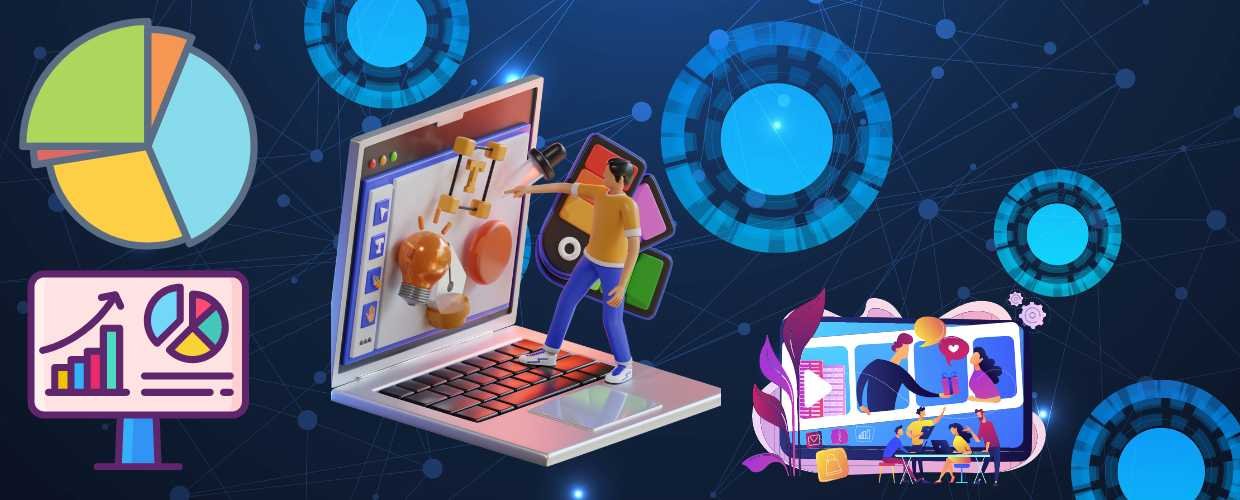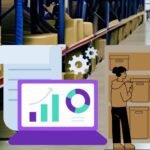Data Visualization has emerged as a powerful means to transform complex datasets into clear, engaging, and meaningful visual narratives in the data proliferation age. In this comprehensive exploration, we embark on a journey into Data Visualization, delving deep into its foundational concepts, diverse techniques, practical applications, benefits, challenges, and pivotal role in shaping how we perceive and comprehend information in today’s data-rich world.
What is Data Visualization?
Data Visualization is an artful fusion of data and design that transforms raw information into compelling visual representations. It bridges the gap between raw data and human cognition, allowing us to glean insights, spot trends, and unravel patterns that might remain hidden in rows and columns of numbers. By harnessing colors, shapes, and graphical elements, Data Visualization distills complex data into easily digestible visuals, enabling us to understand and communicate information effectively.
Key Concepts and Techniques of Data Visualization
Data Visualization is a multi-dimensional canvas that employs various techniques to craft meaningful and impactful visualizations.
Visual Encoding
Visual encoding is at the core of Data Visualization, where data attributes are mapped to visual elements. This mapping involves choosing appropriate shapes, colors, sizes, and positions to represent data points, enabling viewers to perceive variations, comparisons, and relationships effortlessly. Visual encoding is not just a technical aspect; it’s an artistic endeavor that requires understanding the psychology of how humans perceive and interpret visual cues.
Data Aggregation and Summarization
Data sets can be massive, overwhelming our senses. Data Visualization employs techniques like aggregation and summarization to distill intricate data into comprehensible visual representations. This process involves grouping data points and deriving meaningful summary statistics, offering a holistic view without drowning in detail. Effective aggregation strikes a balance between preserving important insights and avoiding oversimplification.
Interactivity
The dynamic nature of interactive Data Visualization invites viewers to engage and explore data themselves. Interactive elements such as filters, tooltips, and zooming empower users to customize their experience, unveil hidden insights, and ask questions directly about the data. Interactive visualizations encourage a sense of discovery, allowing users to drill down into specific details or zoom out for a broader context.
Chart Types and Graphs
The palette of Data Visualization encompasses a myriad of chart types and graphs. From bar charts and line graphs to scatter plots and heatmaps, each visual form serves a distinct purpose in conveying different aspects of data, empowering storytellers to select the most suitable representation. The choice of chart type depends on the nature of the data, the relationships to be highlighted, and the audience’s familiarity with visual conventions.
Color and Aesthetics
Colors evoke emotions and convey information. Data Visualization utilizes color palettes strategically to differentiate categories, highlight trends, and emphasize data points. Aesthetics are vital in ensuring that visuals are informative and visually appealing. However, using color requires caution, as improper color choices can lead to misinterpretation or biased perception of data.
Practical Applications of Data Visualization
Data Visualization is a versatile tool that finds applications across various industries, sparking insights and driving informed decisions.
Business Intelligence and Analytics
In business, Data Visualization is an essential conduit for digesting complex financial data, tracking performance metrics, and identifying market trends. Visual dashboards allow executives to monitor key indicators, enabling agile decision-making and strategic planning. For instance, sales teams can analyze visualizations of revenue trends to adjust strategies and allocate resources effectively.
Scientific Research and Exploration
Data Visualization accelerates scientific discovery by distilling intricate research findings into intuitive visuals. Complex data from genomics, astronomy, and climate science fields is transformed into graphs, maps, and diagrams that reveal patterns and correlations, advancing scientific understanding. Researchers can visualize genetic sequences to identify mutations or visualize climate data to study global temperature trends.
Healthcare and Medical Imaging
Visualizations aid medical professionals in diagnosing diseases, planning surgeries, and analyzing medical images. MRI scans, X-rays, and 3D reconstructions enable accurate interpretations, facilitating precise treatments and improving patient outcomes. For instance, radiologists can visualize scans in three dimensions to assess complex anatomical structures accurately.
Journalism and Storytelling
In journalism, Data Visualization empowers storytellers to communicate complex narratives effectively. Infographics, interactive maps, and data-driven articles enable journalists to convey information in compelling and accessible ways, fostering informed public discourse. Data-driven visuals can be used to explain election results, analyze social trends, or illustrate economic disparities.
Urban Planning and Geographic Analysis
Urban planners and geographers employ visualizations to analyze demographic trends, transportation patterns, and land-use changes. Geographic Information Systems (GIS) combine spatial data with visualization, facilitating informed urban development and resource allocation. Urban planners can use GIS-based visualizations to simulate the impact of new infrastructure projects on traffic flow and cityscape aesthetics.
Benefits of Data Visualization
Integrating Data Visualization into decision-making processes offers various benefits that enhance comprehension, communication, and actionable insights.
Enhanced Data Understanding
Visual representations simplify data comprehension. Complex relationships, trends, and outliers are readily apparent, allowing stakeholders to grasp insights intuitively. Visuals facilitate data literacy among non-technical audiences, enabling better communication between teams and departments.
Effective Communication
Visuals transcend language barriers, enabling effective communication across diverse audiences. Data Visualization fosters clear, succinct, and universally understandable messages, making data-driven insights accessible to all. Charts and graphs can be understood by individuals regardless of their technical background, fostering a shared understanding of information.
Identification of Patterns and Anomalies
Data Visualization excels at revealing hidden patterns and anomalies. Disc discrepancies become glaringly obvious by translating data into visual forms, prompting further investigation and analysis. Visualizations help data analysts and decision-makers spot outliers or unexpected trends that might have been overlooked in tabular data.
Decision-making Support
Visualizations empower decision-makers by presenting comprehensive insights at a glance. In boardrooms and strategy meetings, visuals concisely inform choices by conveying complex information. Interactive dashboards enable executives to explore real-time data scenarios, aiding in strategic planning and resource allocation.
Storytelling Power
Data Visualization is more than charts and graphs; it’s a storytelling medium. Compelling visuals transform data into narratives, engaging audiences emotionally and intellectually. Storytellers can evoke empathy, convey urgency, or inspire action by creating a visual journey through data, creating a memorable and impactful data-driven narrative.
Challenges of Data Visualization
While Data Visualization offers a wealth of benefits, it is not without challenges that must be addressed to ensure accuracy and clarity.
Data Quality and Integrity
The accuracy of visualizations hinges on the quality of underlying data. Inaccurate or incomplete data can mislead interpretations, emphasizing the importance of data verification and validation processes. Without reliable data, even the most beautiful visualization may convey inaccurate insights.
Choosing the Right Visualization
Selecting the appropriate visualization for the data is an art. Misapplied visuals can distort information or misrepresent relationships, underscoring the need for thoughtful selection. Choosing the right chart type requires a deep understanding of the data’s nature and the message you want to convey.
Over-Visualization
An excess of visual elements can overwhelm viewers, diluting the impact of the message. Striking a balance between data richness and simplicity is vital to prevent information overload. Simplicity is a principle in effective Data Visualization, ensuring the audience can focus on the most important insights.
Misinterpretation and Bias
Visualizations can inadvertently introduce bias or misinterpretation if not designed meticulously. Conveying accurate context and avoiding misleading elements are paramount. Data storytellers must recognize the potential for misunderstanding and strive for clarity and transparency in their visualizations.
Technological Limitations
Technical constraints, such as limitations in visualization tools or processing power, can hinder the creation of sophisticated visualizations. Staying abreast of technological advancements is crucial to leverage emerging tools and techniques to overcome these limitations.
Conclusion
Data Visualization emerges as a masterful choreographer in the intricate dance of data interpretation, translating complex data into compelling visual stories. By unearthing insights, enabling effective communication, and guiding strategic decisions, Data Visualization empowers us to extract maximum value from data.
While challenges persist, the rewards of enhanced understanding, effective communication, pattern identification, decision-making support, and storytelling prowess underscore the indispensable role of Data Visualization in illuminating the data-driven landscape. As organizations and individuals navigate the sea of data, the mastery of Data Visualization remains a beacon of clarity, guiding us toward a world where information is understood, felt, experienced, and transformed into actionable knowledge.










